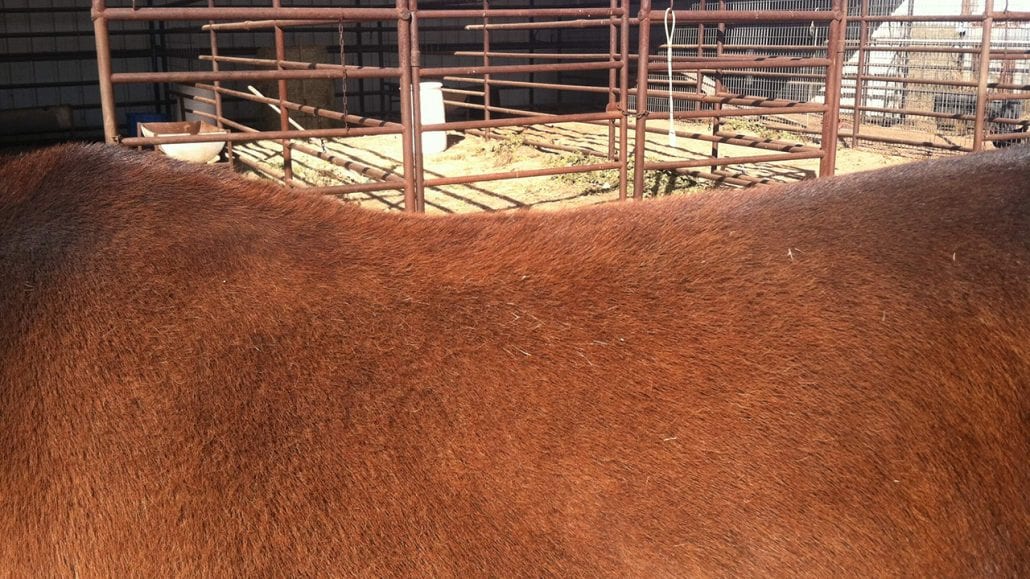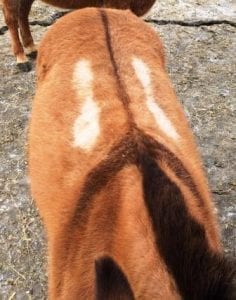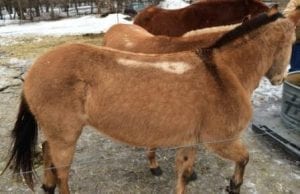White Hairs, Rub Marks, and Bald Spots
Are you noticing white hairs showing up on your mule? Maybe they’re currently just rub marks and maybe they’ve developed all the way into bald spots.
If you’ve noticed your tack leaving marks that are starting to change the complexion of your mule’s hair, this article is for you.
What do white hairs, rub marks and bald spots mean?
You just had a great ride on your mule. You tackled big hills, hopped some rocks, and enjoyed long dirt roads and wooded trails for hours. Back at camp, you are exhausted. Your backside tells you that you have been in the saddle for a long time today, but regardless it was a great day. As you unpack your mule, you find a rub (with lost hair) from your britchen and you have two distinct white patches near the front D-rings of your saddle and a lesser area near the tree in the front. Your first thought is, “I just spent a lot on this mule gear and now it rubs my mule’s hair off and leaves white spots?”
HOLD THE PHONE! Let’s look at reasons for what happened and once we know the causes, we can plan for prevention.
Now it is true that a tack that does not fit well can cause both white hairs and lost hair. No two ways about it. Both represent areas of friction and pressure. However, I must also tell you that you can have a really good fit with your tack and still have these things happen. Yes, you read that correctly – bad things can still happen if you don’t apply the tack correctly or use it as directed.
The Britchen and Lost Hair
As you know, it is important for the britchen to follow the curve of the hip. Exactly where you place the britchen depends on the size of your mule’s hips but it must follow the curve of the hip. The hip safe should rest just behind the croup, and the straps must let the britchen fall into place. Once in place and attached, you should be able to put both hands between the britchen and the hip and feel your mule’s hair on the back of your hands.
Whether you place your britchen high or low on the hip depends on what you plan to do. In the ride described, it would be fine to have the britchen “high” for the long, level dirt roads or wooded trails that were gently rolling. But for those big hills and rocks, you will want to drop your britchen so the mule can “sit on it” while moving over dramatically changing terrain.

Remember that the purpose of the britchen is to work with your breast collar to keep your saddle in one place. I like a britchen so much more than a crupper because it distributes the rider’s weight so much better, can be adjusted easily, and is meant for this purpose. It will keep your saddle from sliding forward, and if properly used, can also help keep your saddle from moving side to side.
As useful as it is, a britchen must be adjusted for this purpose and should have a position change every couple of hours. If it is really hot and humid, this can become critical. Hot, sweaty mules will lose hair more rapidly than cool, dry mules. So pay attention to your time and the condition of your mule. If he begins to sweat, you will want to plan your changes more frequently.
A britchen is a good choice for your mule, but kindly remember to adjust it periodically. The hotter your mule gets, the more easily hair will be lost. And the more your riding conditions change, the more adjustments will be needed. It is usually safe to plan on adjusting your britchen, even if just a little, every couple of hours.
White Hairs
While white hairs can certainly signal ill fitting tack, they can actually appear even if the tack is a good fit. Here are two reasons why:
- You do not apply the tack properly
- You allow your mule to overheat.
Let’s look first at proper application. You are all aware that I endorse the use of my tack package as a unit: non-slip saddle pad, my mule saddle, breast collar, britchen, and front and rear cinch. As a package, this tack promotes keeping your saddle (and you) put! People tend not to understand the mechanics and they will over tighten the front cinch.


If you over-tighten the front cinch, you are creating a massive pressure point on the front of the tree and at the front D ring. It would be like pulling a shoelace tight down by the toes but not as much for the rest of the eyelets. There would be a pressure point – a place where the pressure is more than on the rest of the mule AND where it will cause discomfort. If you add to that scenario a mule that is hot, you will get the potential for a scald. It is very important to use the package correctly. The front cinch only needs to be slightly snugged up. The rear cinch is the tighter of the two – but neither needs to be “cranked down.”
With my no-slip pad, the top of the pad decron interfacing with the saddle fleece will feel like velcro. The combination of materials is why the saddle stays in place. The combination of the breast collar and the britchen all work together to keep your saddle secure.
A Sweaty Mule
The other thing I mentioned was that if your mule overheats, you are more likely to see scolds that result in white hairs. You can tell if your mule is hot by watching his ears. Look at the base of his ears near the skull. If he is sweating there and up a ½ inch or so of his ears, he is starting to overheat. It is time for a break.
When you take a break, remember to give your mule a break too! Loosen his tack, lift the rear of the saddle and pad up so his back can cool off (the sweat will evaporate with the ventilation and help him cool) and allow him to get a drink and rest. You can adjust your britchen at this time as well. If it is hot, you will need more breaks and so will he. If it is early in your riding season or you have not ridden trails of a certain difficulty for some time, breaks will be important as your mule gets into shape. But the long and short of it is this: if you feel warm and sweaty and your behind is stiff, imagine what the mule is feeling! There is no tack on earth that will not cause some kind of pressure if improperly used or used for too long without breaks.
On a side note, there is some hope for those white hairs and lost hair. Most of the time, lost hair will grow back. In the old days, muleskinners used to put urine on these areas to toughen it up! Mouthwash was another home remedy. Nowadays, common sense and using a good tack as it should be, along with consideration for the animal can prevent a lot. Most of those white hairs will grow out if you make the necessary adjustments.
You are not the first person to ride a little too long without a rest, to pull that front cinch a little too tight, or to leave your britchen in one spot for too long. The good news is that it is generally correctable and once you understand how to assess your mule for overheating, it gets easier to prevent these issues.


Remember to use the entire Queen Valley package to ride your mule, and remember to rest him and make adjustments as needed. The result will be a happier mule and a happier rider! As always, feel free to give me a holler with any questions.
- Posted in: Articles, Everything
- Tagged: Articles, Everything



1 thought on “White Hairs, Rub Marks, and Bald Spots”
What is happening when after a nice long ride and I take saddle and pad off the back is wet except behind the scapula and just behind the fat pad. Fur is matted and dry in about a 6×6 circle.
Thanks
Laura H
Missouri